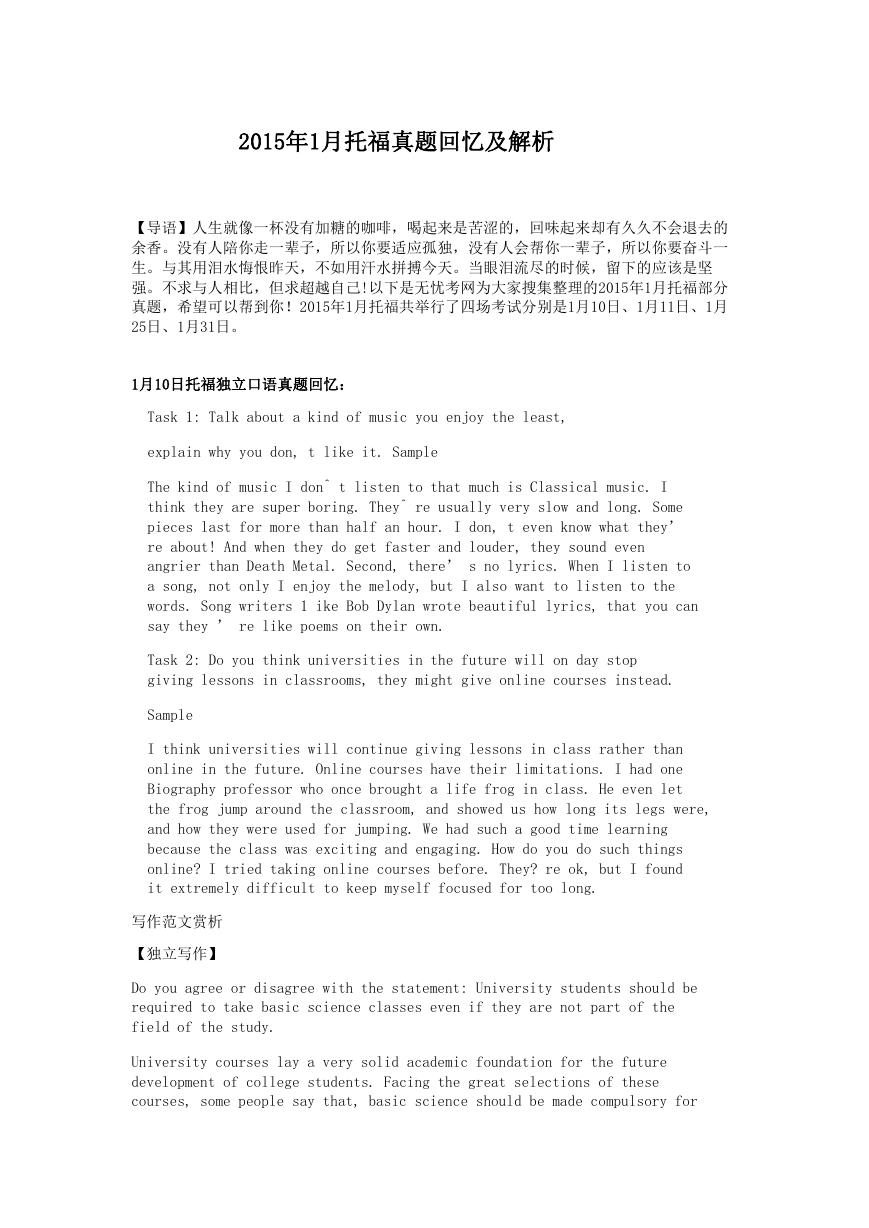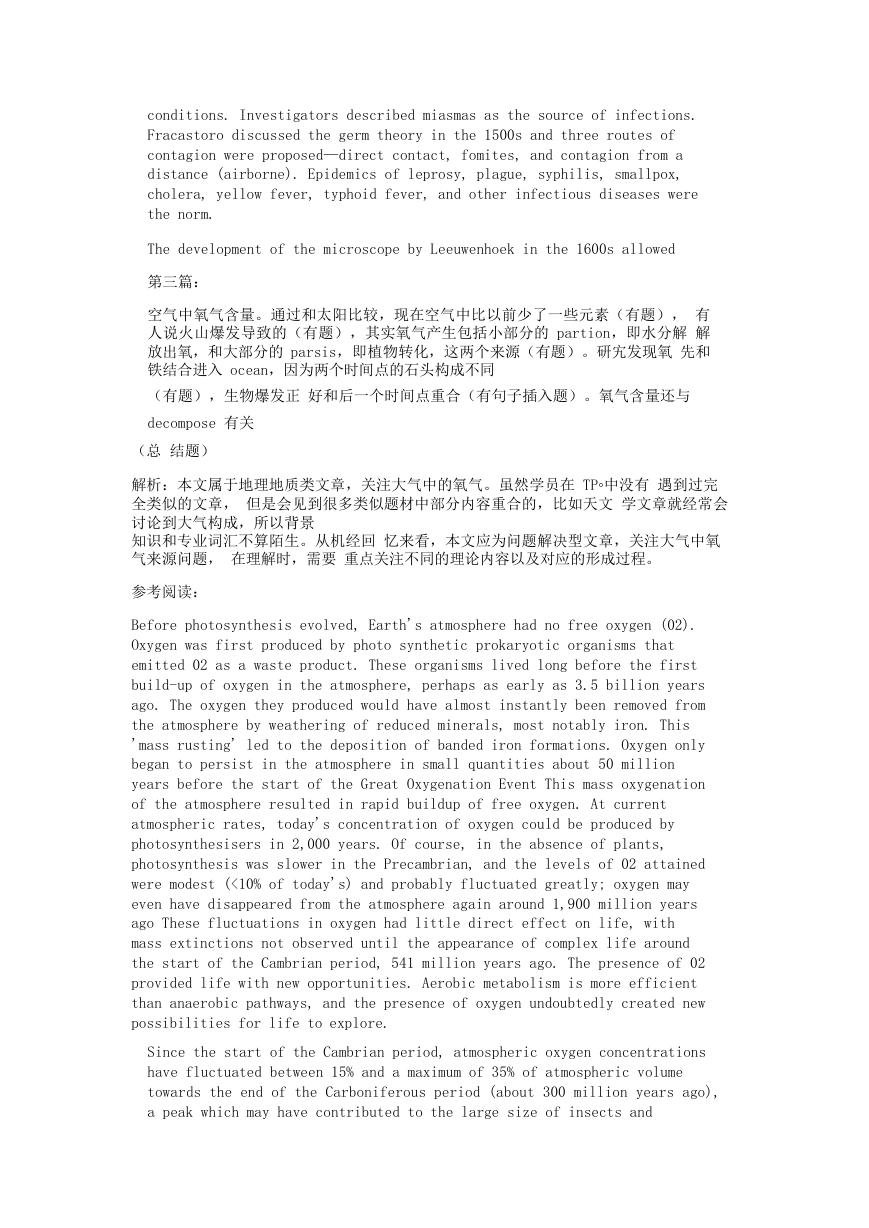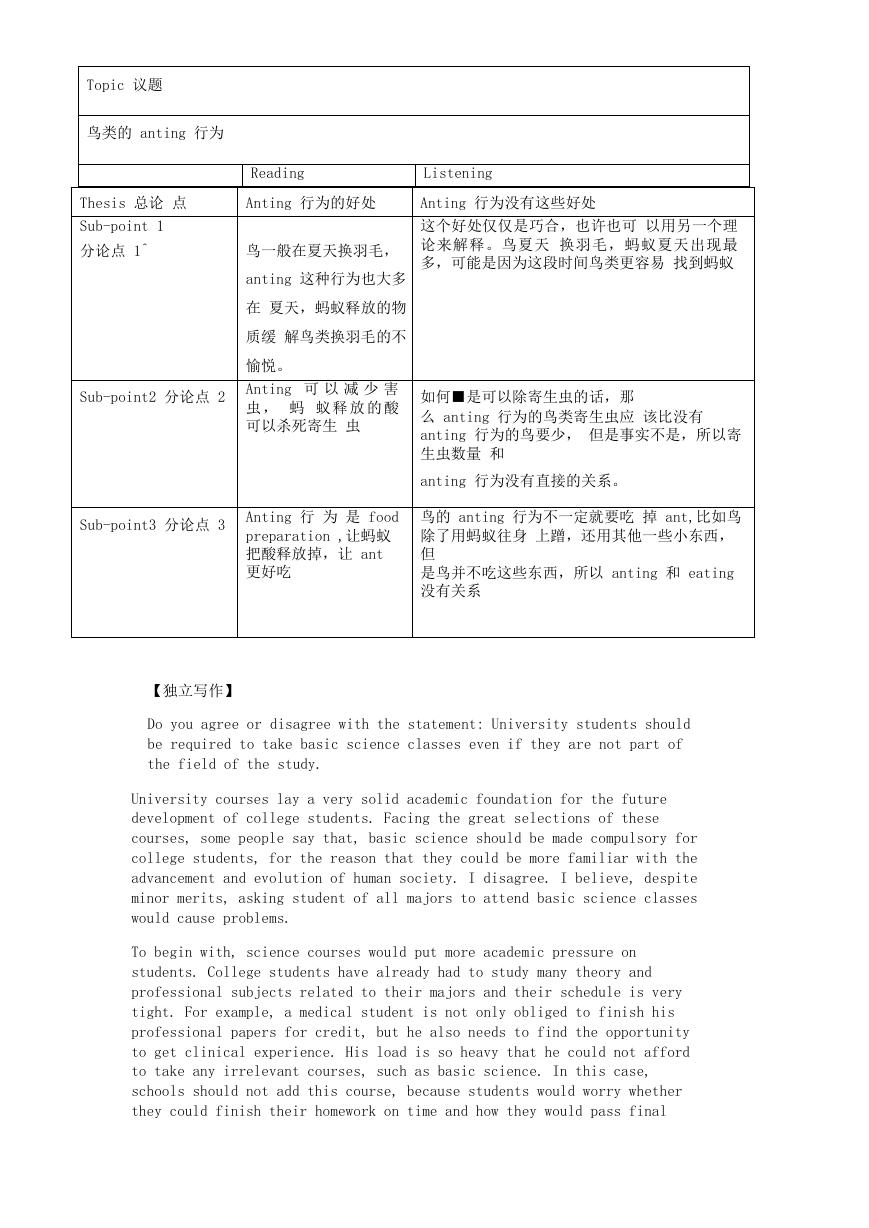2015年1月托福真题回忆及解析
【导语】人生就像一杯没有加糖的咖啡,喝起来是苦涩的,回味起来却有久久不会退去的
余香。没有人陪你走一辈子,所以你要适应孤独,没有人会帮你一辈子,所以你要奋斗一
生。与其用泪水悔恨昨天,不如用汗水拼搏今天。当眼泪流尽的时候,留下的应该是坚
强。不求与人相比,但求超越自己!以下是无忧考网为大家搜集整理的2015年1月托福部分
真题,希望可以帮到你!2015年1月托福共举行了四场考试分别是1月10日、1月11日、1月
25日、1月31日。
1月10日托福独立口语真题回忆:
Task 1: Talk about a kind of music you enjoy the least,
explain why you don, t like it. Sample
The kind of music I don^ t listen to that much is Classical music. I
think they are super boring. They^ re usually very slow and long. Some
pieces last for more than half an hour. I don, t even know what they’
re about! And when they do get faster and louder, they sound even
angrier than Death Metal. Second, there’ s no lyrics. When I listen to
a song, not only I enjoy the melody, but I also want to listen to the
words. Song writers 1 ike Bob Dylan wrote beautiful lyrics, that you can
say they ’ re like poems on their own.
Task 2: Do you think universities in the future will on day stop
giving lessons in classrooms, they might give online courses instead.
Sample
I think universities will continue giving lessons in class rather than
online in the future. Online courses have their limitations. I had one
Biography professor who once brought a life frog in class. He even let
the frog jump around the classroom, and showed us how long its legs were,
and how they were used for jumping. We had such a good time learning
because the class was exciting and engaging. How do you do such things
online? I tried taking online courses before. They? re ok, but I found
it extremely difficult to keep myself focused for too long.
写作范文赏析
【独立写作】
Do you agree or disagree with the statement: University students should be
required to take basic science classes even if they are not part of the
field of the study.
University courses lay a very solid academic foundation for the future
development of college students. Facing the great selections of these
courses, some people say that, basic science should be made compulsory for
�
college students, for the reason that they could be more familiar with the
advancement and evolution of human society. I disagree. I believe, despite
minor merits, asking student of all majors to attend basic science classes
would cause problems.
To begin with, science courses would put more academic pressure on
students. College students have already had to study many theory and
professional subjects related to their majors and their schedule is very
tight. For example, a medical student is not only obliged to finish his
professional papers for credit, but he also needs to find the opportunity
to get clinical experience. His load is so heavy that he could not afford
to take any irrelevant courses, such as basic science. In this case,
schools should not add this course, because students would worry whether
they could finish their homework on time and how they would pass final
examinations.
Furthermore, a required science course would lead to unnecessary cost for
parents and students. To guarantee the quality of lecturing, colleges have
to hire talented and senior science professors and experts, such as those
from the best-known universities or scientific research institutes. This
would increase the cost of schooling. Normally, a lecture given by a famous
science professor costs over 1,000 dollars. These costs would be reflected
in the tuition fee, and would deprive many underprivileged students of an
opportunity for education.
Admittedly, taking basic science courses does have its merits. As a subject
aiming to explain how the universe exits, basic science broaden student' s
range of knowledge and enhance their analytical skills. Students could gain
a deep understanding about the world they live in. Lots of methods to solve
problems will be gained through basic science. However, this knowledge
could be acquired by other method other than required courses. TV
documentaries and books are all available options for student to learn
basic science.
In conclusion, although there are some small benefits to requiring basic
science courses, making every college student attend such classes would
overburden the students both academically and financially.
2015年1月10日托福真题回忆:
.autonomy = independence
adaptation
additional
autonomy = independence
besides
constitution
n.独立、自主
n.适应性
adj.额外的、附加的
n.独立、自主
adv.此外、而且
n.宪法、章程
�
constituent = component
coupled with
deficiencies
diffuse = spread
disperse = scatter
emerging
gradual
predominate
preoccupation n
第一篇:
n.成分
与……结合
n.缺点、不足
V.扩散
V.驱散、扩散
adj.新型的
adj.逐渐的
V.占主导地位
全神贯注
Desease 的三个历史阶段,第一个 infectious 阶段,在这之前很少传染病,因为 人民
居住分散接触不
够(有题),但农业的发展大大增加了 epidemics,包括土 壤里的生物、储存的食物等
因素(有否定题, 应该是选 rotted 那个),第二阶段 是慢性病,医疗发展基本杜绝传
染病,但现代人的生活让慢性病比
如心脏病肺结 核等更普遍(有题),第三阶段是现在,抗药性的细菌(有题)和慢性病
一起来
解析:本文属于生物类与历史类文章的跨学科题材,涉及到少有的医学相关内容。 从
机经回忆来看, 属于流程发展结构,学员在理解时需要重点关注不同发展时期 的不
同特征。因为医学类文章专业词汇过多,而且TP0 也很少遇到相似题材, 在理解
时,学员需要克服过多生词和背景知识陌生带来的焦虑和内耗,重点关注 事情和特
征的对应。
参考阅读:
In 1962 Sir McFarland Burnett stated, 'By the end of the Second World War
it was possible to say that almost all of the major practical problems of
dealing with infectious disease had been solved.' At that time, his
statement was logical. Control and prevention measures had decreased the
incidence of many infectious diseases, and with the ability to continue to
identify new antibiotics, to
handle new problems, and the ongoing development of appropriate
vaccines, his statement appeared to be appropriate.
In the US, similar feelings were expressed and funding for infectious
disease fellowships began to decline with federal resources being
directed elsewhere. The history of the world is intertwined with the
impact that infectious diseases have had on populations. Evidence of
smallpox has been found in 3000-year-old Egyptian mummies. Egyptian
papyrus paintings depict infectious diseases such as poliomyelitis.
Hippocrates wrote about the spread of disease by means of airs, water,
and places, and made an association between climate, diet, and living
�
conditions. Investigators described miasmas as the source of infections.
Fracastoro discussed the germ theory in the 1500s and three routes of
contagion were proposed—direct contact, fomites, and contagion from a
distance (airborne). Epidemics of leprosy, plague, syphilis, smallpox,
cholera, yellow fever, typhoid fever, and other infectious diseases were
the norm.
The development of the microscope by Leeuwenhoek in the 1600s allowed
第三篇:
空气中氧气含量。通过和太阳比较,现在空气中比以前少了一些元素(有题), 有
人说火山爆发导致的(有题),其实氧气产生包括小部分的 partion,即水分解 解
放出氧,和大部分的 parsis,即植物转化,这两个来源(有题)。研宄发现氧 先和
铁结合进入 ocean,因为两个时间点的石头构成不同
(有题),生物爆发正 好和后一个时间点重合(有句子插入题)。氧气含量还与
decompose 有关
(总 结题)
解析:本文属于地理地质类文章,关注大气中的氧气。虽然学员在 TP◦中没有 遇到过完
全类似的文章, 但是会见到很多类似题材中部分内容重合的,比如天文 学文章就经常会
讨论到大气构成,所以背景
知识和专业词汇不算陌生。从机经回 忆来看,本文应为问题解决型文章,关注大气中氧
气来源问题, 在理解时,需要 重点关注不同的理论内容以及对应的形成过程。
参考阅读:
Before photosynthesis evolved, Earth's atmosphere had no free oxygen (02).
Oxygen was first produced by photo synthetic prokaryotic organisms that
emitted 02 as a waste product. These organisms lived long before the first
build-up of oxygen in the atmosphere, perhaps as early as 3.5 billion years
ago. The oxygen they produced would have almost instantly been removed from
the atmosphere by weathering of reduced minerals, most notably iron. This
'mass rusting' led to the deposition of banded iron formations. Oxygen only
began to persist in the atmosphere in small quantities about 50 million
years before the start of the Great Oxygenation Event This mass oxygenation
of the atmosphere resulted in rapid buildup of free oxygen. At current
atmospheric rates, today's concentration of oxygen could be produced by
photosynthesisers in 2,000 years. Of course, in the absence of plants,
photosynthesis was slower in the Precambrian, and the levels of 02 attained
were modest (<10% of today's) and probably fluctuated greatly; oxygen may
even have disappeared from the atmosphere again around 1,900 million years
ago These fluctuations in oxygen had little direct effect on life, with
mass extinctions not observed until the appearance of complex life around
the start of the Cambrian period, 541 million years ago. The presence of 02
provided life with new opportunities. Aerobic metabolism is more efficient
than anaerobic pathways, and the presence of oxygen undoubtedly created new
possibilities for life to explore.
Since the start of the Cambrian period, atmospheric oxygen concentrations
have fluctuated between 15% and a maximum of 35% of atmospheric volume
towards the end of the Carboniferous period (about 300 million years ago),
a peak which may have contributed to the large size of insects and
�
amphibians at that time. Whilst human activities, such as the burning of
fossil fuels, have an impact on relative carbon dioxide concentrations,
their impact on the much larger concentration of oxygen is less
significant.
第二篇:
16 世纪后 r 开头的一个词削弱了 artisans 的繁荣发展(此处有同义句题),一些
技术的发展使得成本上升,手工艺人无法承担(此处有题),原料的买卖大权掌 握在
big merchant 手中(有题),穷手工艺人只能依靠便宜的 local materials (有 推
断题),很多独立的 producers 沦为 big merchant 的
employee,同时,他们 又担心 rural areas 的发展,因为那里成本消费更低,更好
招人(有题+总结题)
解析:本文属于历史类文章,关注的是手工艺者与新兴技术的关系,在 TPO 中 有
许多有关工业化的文章,所以背景知识学员不陌生。从机经回忆来看,属于因 果型
文章,在理解时学员需要重点把握削弱手工艺人发展的原因,以及与其相关 的因果
关系。
参考阅读:
Before 1815 manufacturing in the United States had been done in homes or
shops by skilled artisans. As master craft workers, they imparted the
knowledge of their trades to apprentices and journeymen. In addition,
women often worked in their homes part-time, making finished articles
from raw material supplied by merchant capitalists. After 1815 this older
form of manufacturing began to give way to factories with machinery
tended by unskilled or semiskilled laborers. Cheap transportation
networks, the rise of cities, and the availability of capita! and credit
all stimulated the shift to factory production.
The creation of a labor force that was accustomed to working in factories
did not occur easily. Before the rise of the factory, artisans had worked
within the home. Apprentices were considered part of the family, and
masters were responsible not only for teaching their apprentices a trade
but also for providing them some education and for supervising their moral
behavior. Journeymen knew that if they perfected their skill, they could
become respected master artisans with their own shops. Also, skilled
artisans did not work by the clock, at a steady pace, but rather in bursts
of intense labor alternating with more leisurely time.
The factory changed that. Goods produced by factories were not as finished
or elegant as those done by hand, and pride in craftsmanship gave way to the
pressure to increase rates of productivity. The new methods of doing
business involved a new and stricter sense of time. Factory life
necessitated a more regimented schedule, where work began at the sound of a
bell and workers kept machines going at a constant pace. At the same time,
workers were required to discard old habits, for industrialism demanded a
worker who was alert, dependable, and self-disciplined.
Absenteeism and lateness hurt productivity and, since work was
specialized, disrupted the regular factory routine. Industrialization not
only produced a fundamental change in the way work was organized; it
�
transformed the very nature of work.
The first generation to experience these changes did not adopt the new
attitudes easily. The factory clock became the symbol of the new work rules.
One mill worker who finally quit complained revealingly about "obedience to
the ding-dong of the bell-just as though we are so many living machines."
With the loss of personal freedom also came the loss of standing in the
community.
Unlike artisan workshops in which apprentices worked closely with the
masters supervising them, factories sharply separated workers from
management. Few workers rose through the ranks to supervisory positions,
and even fewer could achieve the artisan's dream of setting up one's own
business. Even well-paid workers sensed their decline in status.
In this newly emerging economic order, workers sometimes organized to
protect their rights and traditional ways of life. Craft workers such as
carpenters, printers, and tailors formed unions, and in 1834 individual
unions came together in the National Trades' Union. The labor movement
gathered some momentum in the decade before the Panic of 1837, but in the
depression that followed, labor's strength collapsed. During hard times,
few workers were willing to strike* or engage in collective action. And
skilled craft workers, who spearheaded the union movement, did not feel a
particularly strong bond with semiskilled factory workers and unskilled
laborers. More than a decade of agitation did finally bring a workday
shortened to 10 hours to most industries by the 1850's, and the courts also
recognized workers' right to strike, but these gains had little immediate
impact.
Workers were united in resenting the industrial system and their loss of
status, but they were divided by ethnic and racial antagonisms, gender,
conflicting not occur easily. Before the rise of the factory, artisans had
worked within the home. Apprentices were considered part of the family, and
masters were responsible not only for teaching their apprentices a trade
but also for providing them some education and for supervising their moral
behavior. Journeymen knew that if they perfected their skill, they could
become respected master artisans with their own shops. Also, skilled
artisans did not work by the clock, at a steady pace, but rather in bursts
of intense labor alternating with more leisurely time.
The factory changed that. Goods produced by factories were not as finished
or elegant as those done by hand, and pride in craftsmanship gave way to the
pressure to increase rates of productivity. The new methods of doing
business involved a new and stricter sense of time. Factory life
necessitated a more regimented schedule, where work began at the sound of a
bell and workers kept machines going at a constant pace. At the same time,
workers were required to discard old habits, for industrialism demanded a
worker who was alert, dependable, and self-disciplined.
Absenteeism and lateness hurt productivity and, since work was specialized,
disrupted the regular
factory routine. Industrialization not only produced a fundamental
change in the way work was organized; it transformed the very nature of
�
work.
The first generation to experience these changes did not adopt the new
attitudes easily. The factory clock became the symbol of the new work rules.
One mill worker who finally quit complained revealingly about "obedience to
the ding-dong of the bell-just as though we are so many living machines."
With the loss of personal freedom also came the loss of standing in the
community.
Unlike artisan workshops in which apprentices worked closely with the
masters supervising them, factories sharply separated workers from
management. Few workers rose through the ranks to supervisory positions,
and even fewer could achieve the artisan's dream of setting up one's
own business. Even well-paid workers sensed their decline in status.
In this newly emerging economic order, workers sometimes organized to
protect their rights and traditional ways of life. Craft workers such as
carpenters, printers, and tailors formed unions, and in 1834 individual
unions came together in the National Trades' Union. The labor movement
gathered some momentum in the decade before the Panic of 1837, but in the
depression that followed, labor's strength collapsed. During hard times,
few workers were willing to strike* or engage in collective action. And
skilled craft workers, who spearheaded the union movement, did not feel a
particularly strong bond with semiskilled factory workers and unskilled
laborers. More than a decade of agitation did finally bring a workday
shortened to 10 hours to most industries by the 1850's, and the courts
also recognized workers' right to strike, but these gains had little
immediate impact.
Workers were united in resenting the industrial system and their loss of
status, but they were divided by ethnic and racial antagonisms, gender,
conflicting religious perspectives, occupational differences, political
party loyalties, and disagreements over tactics. For them, the factory and
industrialism were not agents of opportunity but reminders of their loss of
independence and a measure of control over their lives. As United States
society became more specialized and differentiated, greater extremes of
wealth began to appear. And as the new markets created fortunes for the few,
the factory system lowered the wages of workers by dividing labor into
smaller, less skilled tasks.
1月10曰大陆托福综合口语真题回忆:
�
Topic 议题
鸟类的 anting 行为
Reading
Listening
Thesis 总论 点
Anting 行为的好处
Anting 行为没有这些好处
Sub-point 1
分论点 1^
Sub-point2 分论点 2
鸟一般在夏天换羽毛,
anting 这种行为也大多
在 夏天,蚂蚁释放的物
质缓 解鸟类换羽毛的不
愉悦。
Anting 可 以 减 少 害
虫 , 蚂 蚁 释 放 的 酸
可以杀死寄生 虫
这个好处仅仅是巧合,也许也可 以用另一个理
论来解释。鸟夏天 换羽毛,蚂蚁夏天出现最
多,可能是因为这段时间鸟类更容易 找到蚂蚁
如何■是可以除寄生虫的话,那
么 anting 行为的鸟类寄生虫应 该比没有
anting 行为的鸟要少, 但是事实不是,所以寄
生虫数量 和
anting 行为没有直接的关系。
Sub-point3 分论点 3
Anting 行 为 是 food
preparation ,让蚂蚁
把酸释放掉,让 ant
更好吃
鸟的 anting 行为不一定就要吃 掉 ant,比如鸟
除了用蚂蚁往身 上蹭,还用其他一些小东西,
但
是鸟并不吃这些东西,所以 anting 和 eating
没有关系
【独立写作】
Do you agree or disagree with the statement: University students should
be required to take basic science classes even if they are not part of
the field of the study.
University courses lay a very solid academic foundation for the future
development of college students. Facing the great selections of these
courses, some people say that, basic science should be made compulsory for
college students, for the reason that they could be more familiar with the
advancement and evolution of human society. I disagree. I believe, despite
minor merits, asking student of all majors to attend basic science classes
would cause problems.
To begin with, science courses would put more academic pressure on
students. College students have already had to study many theory and
professional subjects related to their majors and their schedule is very
tight. For example, a medical student is not only obliged to finish his
professional papers for credit, but he also needs to find the opportunity
to get clinical experience. His load is so heavy that he could not afford
to take any irrelevant courses, such as basic science. In this case,
schools should not add this course, because students would worry whether
they could finish their homework on time and how they would pass final
�
















 2023年江西萍乡中考道德与法治真题及答案.doc
2023年江西萍乡中考道德与法治真题及答案.doc 2012年重庆南川中考生物真题及答案.doc
2012年重庆南川中考生物真题及答案.doc 2013年江西师范大学地理学综合及文艺理论基础考研真题.doc
2013年江西师范大学地理学综合及文艺理论基础考研真题.doc 2020年四川甘孜小升初语文真题及答案I卷.doc
2020年四川甘孜小升初语文真题及答案I卷.doc 2020年注册岩土工程师专业基础考试真题及答案.doc
2020年注册岩土工程师专业基础考试真题及答案.doc 2023-2024学年福建省厦门市九年级上学期数学月考试题及答案.doc
2023-2024学年福建省厦门市九年级上学期数学月考试题及答案.doc 2021-2022学年辽宁省沈阳市大东区九年级上学期语文期末试题及答案.doc
2021-2022学年辽宁省沈阳市大东区九年级上学期语文期末试题及答案.doc 2022-2023学年北京东城区初三第一学期物理期末试卷及答案.doc
2022-2023学年北京东城区初三第一学期物理期末试卷及答案.doc 2018上半年江西教师资格初中地理学科知识与教学能力真题及答案.doc
2018上半年江西教师资格初中地理学科知识与教学能力真题及答案.doc 2012年河北国家公务员申论考试真题及答案-省级.doc
2012年河北国家公务员申论考试真题及答案-省级.doc 2020-2021学年江苏省扬州市江都区邵樊片九年级上学期数学第一次质量检测试题及答案.doc
2020-2021学年江苏省扬州市江都区邵樊片九年级上学期数学第一次质量检测试题及答案.doc 2022下半年黑龙江教师资格证中学综合素质真题及答案.doc
2022下半年黑龙江教师资格证中学综合素质真题及答案.doc